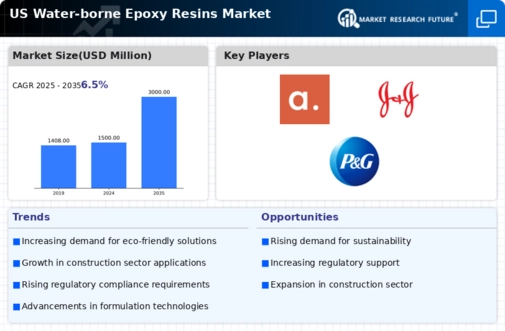Growing Demand from Automotive Sector
The automotive sector is emerging as a significant driver for the water borne-epoxy-resins market. With the automotive industry increasingly focusing on lightweight materials and eco-friendly coatings, water borne-epoxy resins are gaining traction due to their excellent performance characteristics. The shift towards electric vehicles (EVs) and hybrid models is further propelling the demand for advanced coatings that provide durability and aesthetic appeal. It is estimated that the automotive segment could account for approximately 25% of the total market share by 2030. This trend indicates a robust growth trajectory for water borne-epoxy resins, as manufacturers seek to meet the stringent requirements of the automotive industry.
Increased Awareness of Health and Safety
Increased awareness of health and safety among consumers and industries is significantly impacting the water borne-epoxy-resins market. As organizations prioritize worker safety and environmental health, there is a growing preference for low-toxicity materials. Water borne-epoxy resins, known for their reduced VOC emissions, are becoming the material of choice in various applications, including industrial coatings and consumer products. This shift is likely to enhance market growth, as companies that adopt safer materials can improve their brand reputation and comply with health regulations. The trend towards safer alternatives is expected to drive innovation and expand the application scope of water borne-epoxy resins in the coming years.
Technological Innovations in Formulation
Technological innovations in formulation are playing a pivotal role in shaping the water borne-epoxy-resins market. Advances in polymer chemistry and formulation techniques have led to the development of high-performance resins that offer superior properties such as enhanced durability and faster curing times. These innovations are crucial for meeting the evolving demands of various industries, including automotive, aerospace, and construction. The market is witnessing a shift towards more efficient production processes, which could potentially reduce costs and improve product performance. As manufacturers continue to invest in R&D, the water borne-epoxy-resins market is likely to benefit from these advancements, leading to increased adoption across multiple sectors.
Regulatory Compliance and Environmental Standards
The water borne-epoxy-resins market is experiencing a surge in demand due to stringent regulatory compliance and environmental standards. The U.S. government has implemented various regulations aimed at reducing volatile organic compounds (VOCs) in coatings and adhesives. This has led manufacturers to innovate and develop water borne-epoxy resins that meet these requirements. As a result, the market is projected to grow at a CAGR of approximately 6% from 2025 to 2030. Companies that adapt to these regulations not only enhance their market position but also contribute to environmental sustainability, which is increasingly valued by consumers. The emphasis on eco-friendly products is likely to drive further investments in research and development within the water borne-epoxy-resins market.
Rising Construction and Infrastructure Activities
The water borne-epoxy-resins market is significantly influenced by the rising construction and infrastructure activities across the U.S. With the government prioritizing infrastructure development, there is an increasing demand for durable and high-performance materials. Water borne-epoxy resins are favored for their excellent adhesion, chemical resistance, and low environmental impact. The construction sector is expected to witness a growth rate of around 5% annually, which directly correlates with the demand for water borne-epoxy resins. This trend is further supported by the growing preference for sustainable building materials, as water borne-epoxy resins align with green building initiatives. Consequently, the market is poised for substantial growth as construction projects proliferate.

















Leave a Comment